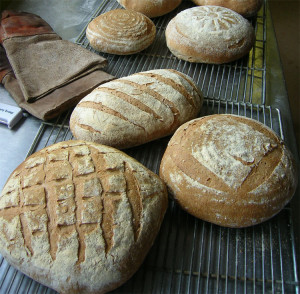Why are sourdoughs better for you?
 Sourdough or wild yeast bread is leavened by natural fermentation. This requires the presence of natural yeasts from the air or the grain, combined with enzyme enhancing bacteria. These cultures grow slowly given the right temperature, digesting the starches and changing the pH, allowing the wild yeasts to feed and the dough to rise.
Sourdough or wild yeast bread is leavened by natural fermentation. This requires the presence of natural yeasts from the air or the grain, combined with enzyme enhancing bacteria. These cultures grow slowly given the right temperature, digesting the starches and changing the pH, allowing the wild yeasts to feed and the dough to rise.
Sourdough baking is a long process, due to the absence of added yeast. From start to finish, the baking process takes up to 36 hours, compared to the 90 minutes of commercial yeasted bread. During this time, wild yeasts and lactobacilli bacteria (the same found in yoghurt), and natural enzymes, get to work, fermenting the dough slowly but surely, pre-digesting the flour so that the bread becomes far more digestible. And in the process, the nutritional properties of the bread change dramatically.
For a start, the glycaemic index of sourdough bread is 68 compared to 100 for non-sourdough bread. This means that sourdough will help you hold your blood glucose in check, according to research at Lund University in Sweden. The lacto-fermentation process actually uses carbohydrates in the food, converts it to lactic acid, and lowers the carbohydrate content. Dr. Andrew Weil in Eating Well for Optimum Health, points out that in cultures in which the traditional diet is still eaten and in which many of civilization’s most common diseases are practically non-existent, most of the staple foods are low glycaemic index carbohydrates.
Our breads are also made from unprocessed flour, containing complex carbohydrates which are readily converted into energy and not stored as fat. Whole meal grains in particular are a good source of essential minerals and trace elementslike calcium, phosphorous, iron, copper, manganese and zinc. These materials fulfil a wide array of functions in the body. Iron, for example, is the building block of haemoglobin and numerous enzymes. It is also critical in the processing of oxygen. Sourdough fermentation increases the availability of minerals due to phytate degradation by microbial and enzymatic activity.
There may also be a cancer deterrent quality to sourdough, according to research by Liljeberg, Lonner & Bjorck (Journal of Nutrition,1995). Lignans, found in rye, which we use in all our bread, are a type of botanical oestrogen, which are converted into biologically active substances that counter the growth of hormone-dependent tumours. In particular, lignans are known to protect against breast, prostate and colon cancer. They also help to prevent heart and blood vessel diseases.
There is increasing interest by health professionals in the benefits of beneficial bacteria in many foods. A balance of the appropriate flora is critical to ensuring not only a healthy intestinal tract, but also for long-term health through protection against pathogenic organisms and supporting gastro-intestinal health. The most important friendly bacteria are lactobacillus, which are cultivated in sourdough fermentation. They produce lactic, formic and acetic acids, which inhibit other organisms due to the acid environment, a good example being E. coli.
The yeast and bacteria themselves provide B vitamins and biotin (important for vegetarians). Bran in whole grain flour is also pre-digested in this process so that its minerals and vitamins are more easily absorbed by the body. The enzymatic properties of sourdough also aids digestibility. Natural antioxidants in the whole grain flours also reduce exposure to toxins.
The yeasts in these breads are gentle in their action and compatible with the way the body processes natural foods such as fruit.
Why we avoid commercial bread
Commercial bread is all about speed of processing. This makes it cheap, uniform, tasteless and with a flabby texture, with all kinds off additives to stop it from going dry and mouldy (sourdoughs have natural resistance to going mouldy and last much better). Large amounts of commercial yeast are used to fluff up the bread quickly and there are residues of unprocessed yeast in the bread. The yeast used is designed to be quick working, is fed on sugar residues and inorganic fertilisers with a number of other chemical additives, and is not easily digested by the body.
Bread standards allow commercial bakers to include a whole array of flour improvers, sweeteners, colours, flavour enhancers, texturisers, preservatives, and enzymes. The presence of these additives must be on the label, but there is no requirement to name the chemicals. These additives are only needed because commercial bakers force flour do things it can’t do naturally – like turn into real bread quickly.
It’s no surprise to us that many people have yeast or wheat intolerance when this is going on. Many who can’t deal with normal bread find our sourdoughs fine to eat.
Organic food
The arguments in favour of organic food are diverse, from environmental issues to social and economic. Health benefits include higher levels of minerals and vitamins, anti-oxidants, and essential fatty acids, as well as the avoidance of pesticide cocktails. A great fact sheet is available on the Soil Association website – click here to read it.
